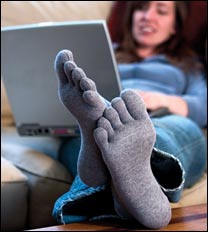Neuromas
What is a Neuroma?
A neuroma is a painful condition, also referred to as a “pinched nerve” or a nerve tumor. It is a benign growth of nerve tissue frequently found between the third and fourth toes that brings on pain, a burning sensation, tingling, or numbness between the toes and in the ball of the foot.
The principal symptom associated with a neuroma is pain between the toes while walking. Those suffering from the condition often find relief by stopping their walk, taking off their shoe, and rubbing the affected area. At times, the patient will describe the pain as similar to having a stone in his or her shoe. The vast majority of people who develop neuromas are women.
Symptoms
•Pain in the forefoot and between the toes.
•Tingling and numbness in the ball of the foot.
•Swelling between the toes.
•Pain in the ball of the foot when weight is placed on it.
How Do You Get a Neuroma?
Although the exact cause for this condition is unclear, a number of factors can contribute to the formation of a neuroma.
Biomechanical deformities, such as a high-arched foot or a flat foot, can lead to the formation of a neuroma. These foot types bring on instability around the toe joints, leading to the development of the condition.
Trauma can cause damage to the nerve, resulting in inflammation or swelling of the nerve.
Improper footwear that causes the toes to be squeezed together is problematic. Avoid high-heeled shoes higher than two inches. Shoes at this height can increase pressure on the forefoot area.
Repeated stress, common to many occupations, can create or aggravate a neuroma.
What Can You Do for Relief?
Wear shoes with plenty of room for the toes to move, low heels, and laces or buckles that allow for width adjustment.
Wear shoes with thick, shock-absorbent soles and proper insoles that are designed to keep excessive pressure off of the foot.
High heels should be avoided whenever possible because they place undue strain on the forefoot and can contribute to a number of foot problems.
Resting the foot and massaging the affected area can temporarily alleviate neuroma pain. Use an ice pack to help to dull the pain and improve comfort.
For simple, undeveloped neuromas, a pair of thick-soled shoes with a wide toe box is often adequate treatment to relieve symptoms, allowing the condition to diminish on its own. For more severe conditions, however, podiatric medical treatment or surgery may be necessary to remove the tumor.
Use over-the-counter shoe pads. These pads can relieve pressure around the affected area.
Treatment by Your Podiatric Physician
Treatment options vary with the severity of each neuroma, and identifying the neuroma early in its development is important to avoid surgical correction. Podiatric medical care should be sought at the first sign of pain or discomfort; if left untreated, neuromas tend to get worse.
The primary goal of most early treatment regimens is to relieve pressure on areas where a neuroma develops. Your podiatric physician will examine and likely X-ray the affected area and suggest a treatment plan that best suits your individual case.
Padding and Taping: Special padding at the ball of the foot may change the abnormal foot function and relieve the symptoms caused by the neuroma.
Medication: Anti-inflammatory drugs and cortisone injections can be prescribed to ease acute pain and inflammation caused by the neuroma.
Orthotic Devices: Custom shoe inserts made by your podiatrist may be useful in controlling foot function. An orthotic device may reduce symptoms and prevent the worsening of the condition.
Surgical Options: When early treatments fail and the neuroma progresses past the threshold for such options, podiatric surgery may become necessary. The procedure, which removes the inflamed and enlarged nerve, can usually be conducted on an outpatient basis, with a recovery time that is often just a few weeks. Your podiatric physician will thoroughly describe the surgical procedures to be used and the results you can expect. Any pain following surgery is easily managed with medications prescribed by your podiatrist.
Your Feet Aren’t Supposed to Hurt
Remember that foot pain is not normal, and any disruption in foot function limits your freedom and mobility. It is important to schedule an appointment with your podiatrist at the first sign of pain or discomfort in your feet, and follow proper maintenance guidelines to ensure their proper health for the rest of your life. The advice in this pamphlet should not be used as a substitute for a consultation or evaluation by a podiatric physician.
Neuroma Tips
•Wear shoes with plenty of room for the toes to move, low heels, and laces or buckles that allow for width adjustment. "Your 2 Feet" carries a diverse variety of these shoes for you to view.
•Wear shoes with thick, shock-absorbent soles and proper insoles that are designed to keep excessive pressure off of the foot. Choose from 5 different types of insoles/arch supports including custom made orthoses fabricated by Dr. Kerch.
•High heels should be avoided whenever possible because they place undue strain on the forefoot and can contribute to a number of foot problems.
•Resting the foot and massaging the affected area can temporarily alleviate neuroma pain. Use an ice pack to help to dull the pain and improve comfort.
•For simple, undeveloped neuromas, a pair of thick-soled shoes with a wide toe box is often adequate treatment to relieve symptoms, allowing the condition to diminish on its own. For more severe conditions, however, podiatric medical treatment or surgery may be necessary to remove the tumor.
•Use over-the-counter shoe pads. These pads can relieve pressure around the affected area. A specially designed metatarsal pad carried at "Your 2 Feet" can assist in relieving neuroma pain.
















